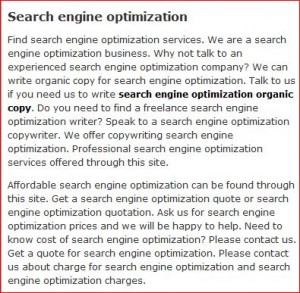Entries Tagged 'UK copywriter' ↓
December 9th, 2011 — copywriting, copywriting tips, freelance copywriting, Suffolk copywriter, UK copywriter
In A Copywriter Gives Power to the Words we looked at the power words that can help convey your message clearly a nd concisely to your reader.
nd concisely to your reader.
But there is one very important word that I omitted to mention – “you”.
Why? Well believe it or not, freelance copywriters are actually human beings. We may well be shut away in our offices, sat in front of our computers being creative but we do also have lives and get to go out now and again.
Therefore it is important that copywriters use words to convey their humanness and the best one do that is you.
Writing using those three letters isn’t always easy though. If you have an academic background of any type (we all have) you would have been told time and time again not to address your reader directly.
Well, now you are writing sales material which is completely different and it is obligatory to use “you”, “yours” and “your”.
Everyone wants to be seen as an individual – and who is the person that people find more fascinating than anyone else? Themselves! Therefore always use “you” instead of “I”. So for example, instead of saying:
“Order now and I will send you a free gift”
Say
“Order now and you will receive a free gift.”
If you do have to write about yourself then “I” and “we” are better than your company name as it keeps it more personal and involving.
So remember – you are human, you exist, so talk to your reader conversationally – don’t talk at them from a distance.
Sally Ormond
June 17th, 2011 — copywriter, copywriting, Copywriting careers, copywriting tips, UK copywriter
 If you’re thinking about becoming a copywriter, there’s one thing you must get – a very thick skin.
If you’re thinking about becoming a copywriter, there’s one thing you must get – a very thick skin.
Over the years mine has thickened to rival any Rhino – that doesn’t conjure a particularly attractive image, but it is a necessity when you write for a living.
I’ve been in business as a freelance copywriter since 2007. I’m pretty good at what I do, in fact I would go so far as to say I’m an expert in my field – that’s why companies from all over the world come to me when they need help with their marketing copy.
The process is fairly simple:
- The client makes contact
- I ask for a full brief on which to base a quote
- They say ‘yes please’
- I write the copy
- They review it
- Everyone’s happy
OK, in an ideal world it would work that way. But frequently there’s a few extra steps added between 5 and 6.
You will soon discover that, no matter how experienced you are, clients will criticise your copy. I will admit that when I first started out this was, at times, hard to take. After all, I’d spent hours pouring over concepts to come up with the finished article.
Some won’t like the approach you’ve taken, others will tell you how they would write it – even though you’re the professional they’ve hired to do the work.
But the one thing you have to remember is that the criticism isn’t directed at you personally.
Copywriting is a very collaborative process. Sometimes you’ll hit it right first time and there’ll be no amendments to be done. Other times there may be a few tweaks needed and the key is to talk to your client, discuss their ideas and together produce a revised version.
Just like art, writing is very subjective – what you know is right may not be so obvious to your client.
So what do you do when they change your copy?
First, take a deep breath. Then review what they’ve said, make any change requests that are valid and then take the time to explain why you wrote the copy in the way you did. Show them the elements within the copy and how they work together. Be confident and stand up for what you believe to be right (without causing an unpleasant scene) and if you know what they are asking you to do is wrong, tell them – nicely.
They’ll have far more respect for you if you take the time to explain a concept than if you say “OK, if that’s how you want it written” knowing full well it won’t achieve the results they’re looking for.
At the end of the day, believe in yourself and your abilities but leave your ego at the door. Plus it also helps to keep sound bites to hand from clients who were happy with your work so in moments of self doubt you can remind yourself how good you are.
March 30th, 2011 — copywriter, copywriting tips, email copywriting, email marketing, UK copywriter
 If your business is new to email marketing working out how to get people to open your emails can be a real headache.
If your business is new to email marketing working out how to get people to open your emails can be a real headache.
Mind you, you don’t even have to be a newcomer to email marketing to feel the frustration.
The problem is the success of your email all comes down to the recipient, the type of day they are having and the amount of time they have.
Little wonder then why it can seem an up hill struggle to get your emails opened and read.
Improve your email open rates
This is a short list of 5 very simple things you can do to give your email open rate a boost. Some of them may seem obvious but I think it helps every now and then to restate what many people over look.
1. When?
The day on which you send your mail will have a big effect on whether it’s opened or not.
Generally speaking Mondays and Fridays are not good days. On a Monday most people are wading through emails that weren’t cleared the week before, came in over the weekend or they just haven’t gotten into gear yet.
Fridays are bad because people are winding down for the weekend and they don’t have time to read your email.
So, in general, the best days to send are Tuesday, Wednesday or Thursday.
2. Subject line
Subject lines are difficult to write. Not only do they have to grab attention and make the recipient want to open your email, they also have to avoid spam filters.
Including things like ‘discounted offer’ or ‘free product’ or ‘free trial’ will get attention but you must test them to make sure they don’t trip any spam filters.
Another good way of drawing attention to your email is by using your brand name – especially if it’s one the recipient will instantly recognise.
3. How often?
When’s too much or too little?
Getting the frequency right is vital. As a general rule, once a month is ideal. If you bombard your readers with several emails a week they’ll soon get fed up and unsubscribe.
Equally if you send them only once every 6 months or so (or at random intervals) they may forget they’d subscribed in the first place and delete it.
4. List
Your list – who you email to – is vital which is why it’s always best to build your own rather than buy one in.
If someone has signed up for your emails there’s a pretty good chance they want to hear from you. if you buy in a list you are ‘cold emailing’ and they’ll probably end up being deleted.
5. Ask
Sending out emails willy-nilly is fine if you just want to fill them with stuff you want to say. But what about what your reader what’s to hear?
Every so often its good practice to ask them what they want to see so you can be sure the information you are passing to them is what they want to read.
Email marketing is great if you get it right but it takes time to perfect.
Sally Ormond – freelance copywriter
March 28th, 2011 — copywriter, copywriting, copywriting tips, marketing, sales writing, UK copywriter
Can you really tell whether copy is good or bad just by looking at it?
The answer is yes and no.
It rather depends on what the copy is, what it’s meant to do and what form it takes.
For example if it’s SEO copywriting and it’s very obvious what the targeted keyword is, like in the example below…

…then it’s pretty safe to say it’s bad copy.
The problem is a section of text can be very well written (grammatically correct and no spelling errors) and yet, from a sales perspective, it’s about as useful as a chocolate teapot.
That’s why it’s not always easy to spot bad copy.
It’s probably easier to look at this from a different angle and think about what makes good copy.
The traits of good copy
Luckily there are 5 characteristics that good copy has. No matter which format it’s written for or what it’s trying to sell, good copy will always:
- Grab the readers’ attention immediately
- Be clear and unambiguous
- Answer all the readers’ questions and so counter any buying objections they may have
- Build trust and rapport with the reader
- Motivate the reader into taking a specific action through a strong call to action
What it comes down to is this – copy is written for a purpose (generally to sell something) but if it doesn’t fulfil that purpose it’s not doing its job.
Selling through text alone is difficult. You don’t have the personal contact with the customer; you can’t think on your feet to counter their buying objections and you can’t shake their hands.
Your copywriting has to do every thing:
- Inform
- Build trust
- Convince
- Convert into a sale
That’s not an easy thing to achieve.
What are your thoughts? Can you think of any more traits you find in good copy? Why not share them here along with any shocking examples of copy you’ve come across.
December 31st, 2010 — Content writer, copywriter, freelance copywriter, freelance copywriting, online copywriting, UK copywriter

As a copywriter I am frequently asked by people how to write effective copy.
Creating something that is interesting, relevant and that sells isn’t always as easy as it sounds.
There are a number of factors that have to be taken into consideration when creating copy for your website, brochure, newsletter, email campaign etc.
You must think about your audience, why you’re writing, what you want to achieve from it and that’s before you start looking at it from your customers perspective.
The easiest way to explain effective copy is to look at it from a ‘questions point of view’—put on your journalist’s hat and follow me…
W-W-W-W-W-H
Who?
Who is your product going to help? This will identify your target market and help you develop the right tone and voice through which you’ll convey your message.
What?
What am I writing about? What will it mean to my customers? This will help you identify the main benefits of your product or service. After all it’s the benefits that will persuade your reader to buy. It’s all about what it will do for them.
When?
Will your product help them now or in the future? How long will your offer last? Timing is crucial, especially with your offer.
Where?
Where can they order or buy your product? If they don’t know how they can get hold of it, how can they buy it? This might sound obvious but you’d be amazed at how many people forget this simple detail.
Why?
Why should they buy it? Yes we’re back to those benefits again. Why is it going to make their life better?
How?
Make sure you let them know how it works, how much it costs, how they can buy it etc.
Once you’ve covered all of those points you must also:
- Keep it simple – write in simple language, with simple sentences. Don’t use jargon as that is a real turn-off.
- Call to action – remember to always tell your reader what you want them to do (call now, buy now, sign up now etc.) otherwise they’ll just walk away.
- Honesty – it really is the best policy. If you make claims about your offerings make sure they are genuine. You want to build a relationship of trust.
- Offer – if you want your offer to appeal to your market make sure it fulfils their needs. To add extra impact make it time limited or limit it by number.
The main thing to remember when writing copy is always have your reader in mind, tell them what they want to know, make an offer that will appeal to them and leave them in no doubt as to why their lives will be enhanced by it.
 nd concisely to your reader.
nd concisely to your reader. If you’re thinking about becoming a
If you’re thinking about becoming a  If your business is new to
If your business is new to 






